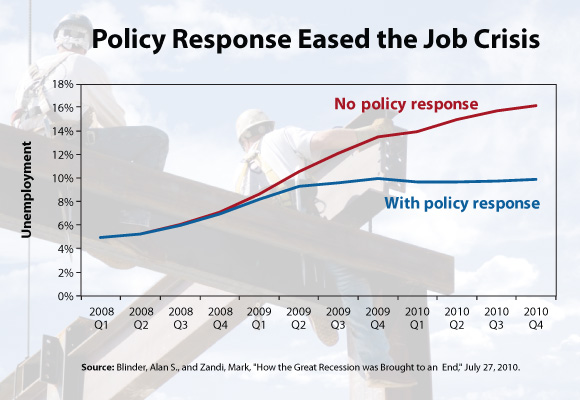Today, with nationwide unemployment close to 10% and millions of jobs still needed to return to pre-recession employment levels, it can be easy to overlook the enormous economic progress that has been made since early 2009, when monthly job losses averaged almost 750,000 and GDP was severely contracting. Princeton Economist Alan Blinder and Mark Zandi, chief economist at Moody’s Analytics, say that a series of federal policy initiatives succeeded in bringing the economy back from the brink and setting it on a course of recovery. The Figure, constructed from data in their report How the Great Recession Was Brought to an End, includes estimates for unemployment without the stimulus investments made through the American Recovery and Reinvestment Act, financial market interventions, and a series of other policy initiatives. It shows that, if the federal government had not intervened to rescue the economy, the unemployment rate would be close to 16% today.

The report by Blinder and Zandi takes a comprehensive look at a series of policy initiatives adopted in 2008 and early 2009 in response to the cratering economy. These include the American Recovery and Reinvestment Act, the Troubled Asset Relief Program (TARP), the rescue of the housing and auto industries, and the establishment of new credit facilities to improve liquidity in financial markets. The report shows that, absent these actions, the country would have 8.5 million fewer jobs and economic output would be $1.5 trillion lower.
The authors acknowledge that because the economy remains weak, all of these policy initiatives have been widely criticized as being expensive and ineffective. But they say that criticism lacks perspective of how bad things were. “From the perspective of early 2009, this rapid snap back was a surprise,” they state. “The Great Recession gave way to recovery as quickly as it did largely because of the unprecedented responses by monetary and fiscal policy makers.” The fact that unemployment remains as high as it is today speaks to the magnitude of the economic crisis and the need for continued policy intervention to create more jobs.
